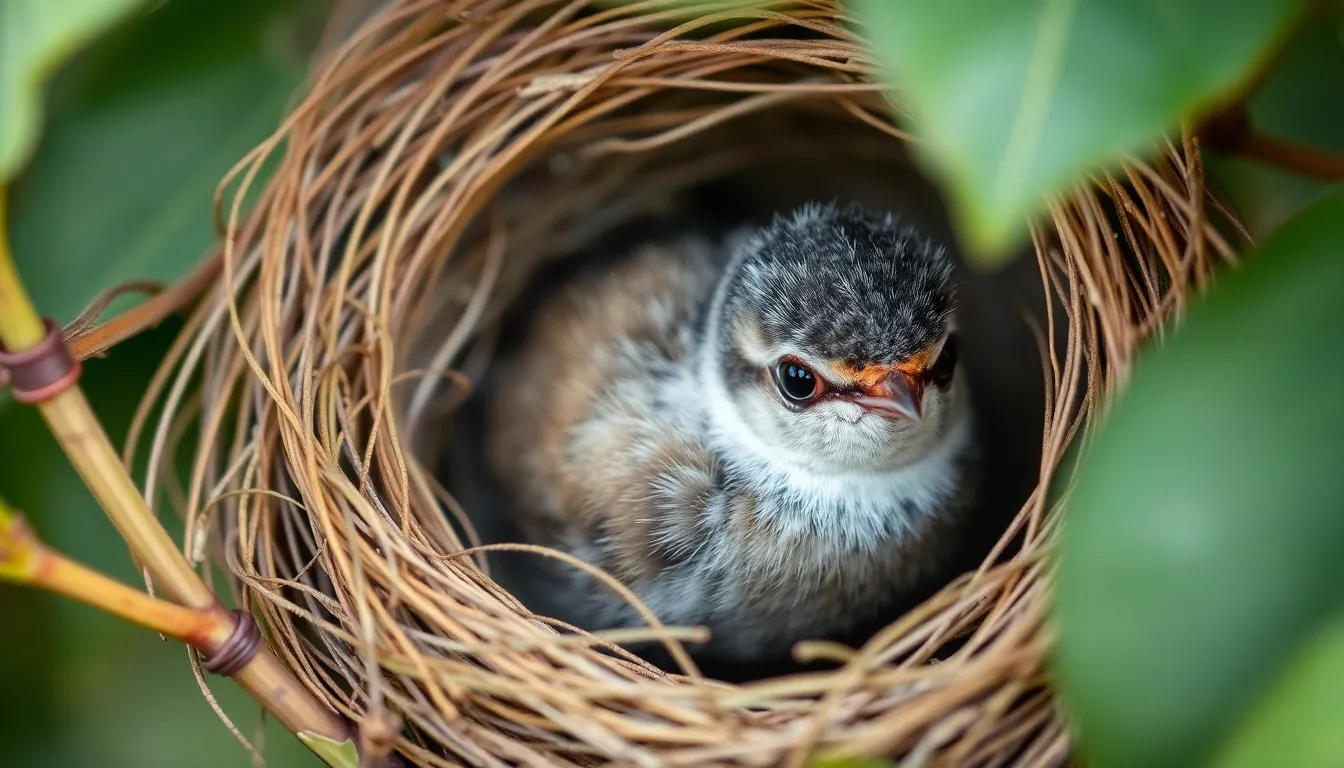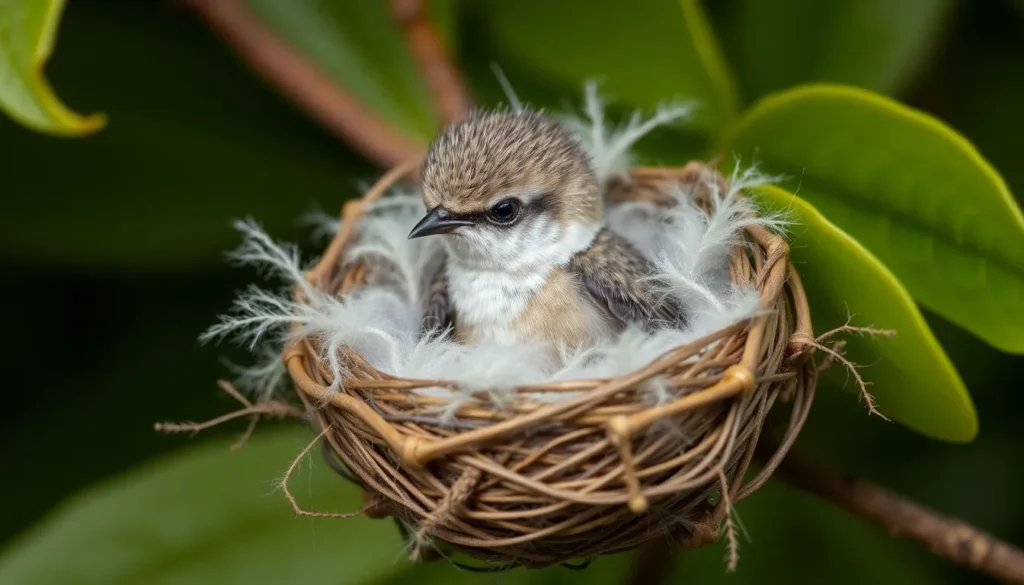Table of Contents
ToggleWhen it comes to nature’s wonders, baby hummingbirds might just take the cake—or at least the nectar! These tiny creatures pack a punch in the cuteness department, but what do they really look like? Imagine a fluffy little ball of feathers that seems to have been designed by a cartoonist with a flair for the whimsical.
Overview Of Baby Hummingbirds
Baby hummingbirds exhibit characteristics that make them truly unique. At birth, these birds are incredibly small, measuring around one inch in length. Their bodies appear fragile, covered in a soft, downy layer of feathers that provides insulation. Colors become more pronounced as they mature, but initially, they may display muted shades of brown or gray.
Eyes remain closed during the early days of life, preventing them from seeing their surroundings. Eventually, they open, revealing dark irises that sparkle with curiosity. Beaks emerge short and delicate at first, yet they develop into the longer, specialized structures necessary for feeding on nectar.
Vocalizations start as soft, high-pitched sounds, distinguishing them from adult hummingbirds. Often, they chirp to communicate with their mothers. Growth occurs rapidly; within a few weeks, they demonstrate notable size increases and feather development.
Nesting plays a crucial role in their early life; mothers build intricate nests using plant materials and spider silk, creating a safe environment for their young. Hummingbird nests are typically cup-shaped, providing security from predators and harsh weather conditions.
Feeding habits revolve around regular nectar consumption. Mother hummingbirds feed their chicks a mixture of nectar and insects, vital for their rapid growth. As they mature, chicks develop the coordination needed for independent feeding.
Behavior changes significantly as they approach fledging age. Young hummingbirds begin to stretch their wings and test their flying abilities. Soon, they prepare for their first flight, leaving the safety of the nest to embrace the world.
Physical Characteristics

Baby hummingbirds showcase unique and adorable features that evolve as they grow. Notably, their size and feather development play critical roles in their early life stages.
Size And Weight
At birth, baby hummingbirds measure around one inch long, making them one of the tiniest birds in the world. Weighing less than a gram, their minuscule size adds to their delicate appearance. Such small dimensions offer easy concealment in nests, essential for protection against predators. As they mature, they gradually gain weight and length, preparing for flight. By the time they fledge, they grow several times larger, increasing their chance of survival in the wild.
Feather Development
Feather development begins shortly after birth, with babies covered in soft, downy feathers. Initially, these feathers appear in muted shades of brown or gray, providing camouflage in their natural habitat. Over time, vibrant colors emerge, signaling maturity. Rather than developing large feathers all at once, they grow in stages, allowing them to gradually acclimate to their surroundings. Eventually, their adult plumage will feature brilliant iridescence, crucial for attracting mates and surviving in a competitive environment.
Coloration And Markings
Baby hummingbirds initially exhibit soft downy feathers in muted shades of brown or gray. Their small bodies lack the vibrant colors seen in adults, allowing them to blend into their surroundings for protection. Closed eyes characterize their first days, making them reliant on their mothers for care.
Initial Appearance
At birth, these tiny creatures measure approximately one inch in length. Downy feathers cover their fragile bodies, forming a fluffy appearance that adds to their cuteness. Limited coloration aids in camouflage within the nest, enhancing their survival chances. Each feather remains soft and unstructured during this early stage, contributing to their delicate look. Newborn hummingbirds also display disproportionately short and weak beaks, a feature that indicates their reliance on parental feeding.
Changes Over Time
As they grow, colors evolve from muted tones to more vibrant hues. Feathers gradually mature, revealing hints of iridescence that foreshadow the stunning plumage of adulthood. Observers notice marked changes within weeks, including lengthening beaks that adapt to nectar feeding. Wing development becomes evident, allowing the fledglings to stretch and explore. This transformation not only enhances their appearance but also signifies readiness for independence. The shift from dull shades to bright colors plays a vital role in attracting mates as they reach maturity.
Growth Stages
The growth stages of baby hummingbirds encompass critical periods in their development. Observing these stages reveals dramatic transformations.
Hatchling Stage
In the hatchling stage, baby hummingbirds emerge from their eggs, measuring about one inch long. Fragile bodies remain covered in soft, downy feathers that offer minimal insulation. Eyes remain closed, leaving them entirely dependent on their mother for warmth and nourishment. Mothers feed them a diet rich in nectar and small insects, providing essential nutrients for rapid growth. The muted colors—mainly gray or brown—help with camouflage, keeping them safe from predators. Hatchlings exhibit little movement, focusing on digesting food and growing.
Juvenile Stage
During the juvenile stage, baby hummingbirds start showcasing noticeable physical changes. Growth accelerates, and their feathers shift from downy to more defined plumage, revealing the hints of brighter colors. Beaks lengthen, adapting toward the needs of nectar feeding. Increased mobility becomes apparent as they begin stretching their wings and practicing hovering. Vocalizations evolve from soft sounds to clearer chirps. This active behavior prepares them for flight, marking a pivotal shift towards independence. Observation of these changes emphasizes their remarkable journey from hatchling to a young bird poised for adventure.
Baby hummingbirds embody the magic of nature with their enchanting appearance and rapid growth. From their initial fragile state to their vibrant plumage, these tiny creatures undergo a remarkable transformation. Their dependence on their mothers during the early stages highlights the nurturing aspect of their life cycle. As they prepare for independence, their playful behaviors and developing skills showcase their readiness to embrace the world. Observing this journey offers a glimpse into the wonders of wildlife and the beauty of life’s beginnings. Baby hummingbirds truly capture the heart and imagination of those fortunate enough to witness their growth.







